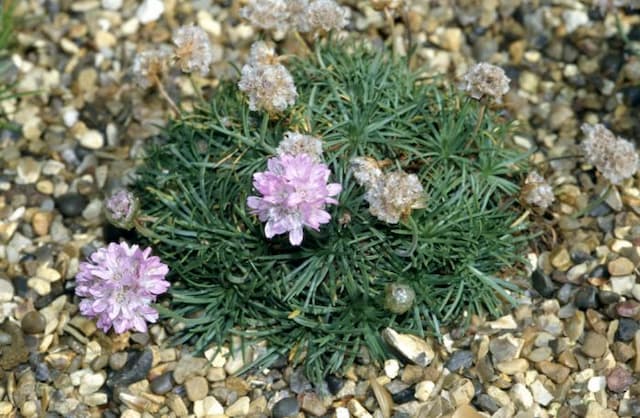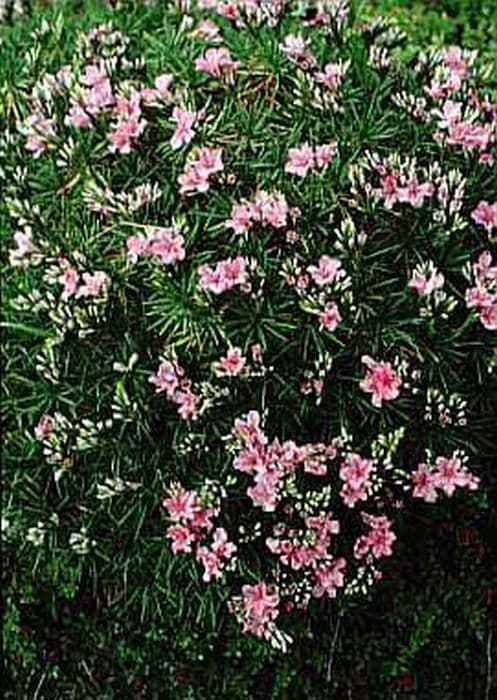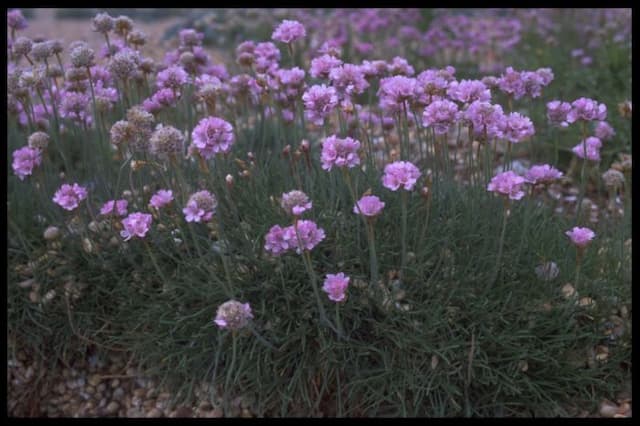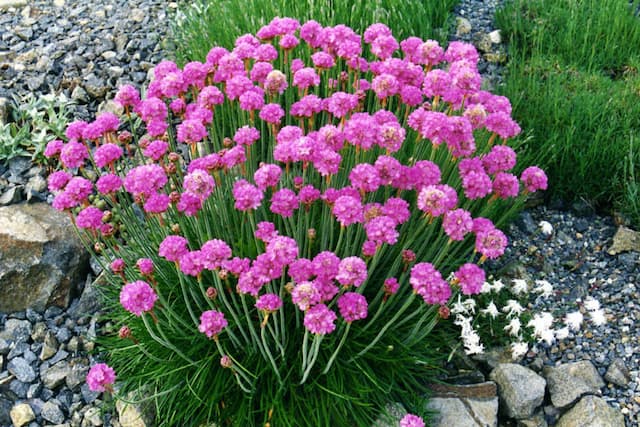Limonium sinuatum 'Forever Gold'

ABOUT
The plant in question, commonly known as statice, displays a visually striking appearance. 'Forever Gold' is a variety that features vibrant, tiny flowers tightly clustered together forming a cushion-like shape at the tips of wiry stems. These flowers are a dazzling mix of, as the name implies, golden hues that add a rich tapestry of color to the plant's profile. The blooms give off a papery texture and tend to retain their color even when dried, making them a popular choice for both fresh and dried flower arrangements. Contrasting the bright blooms are the foliage of statice, which consists of wavy-edged leaves. The leaves create a lush green backdrop that accentuates the gold tones of the flowers. The plant's overall form is bushy, with a profusion of stems and flowers creating a full, rounded look that is both airy and substantial, presenting an interesting ensemble of color and form that is visually delightful for gardens and floral displays.
About this plant
 Names
NamesFamily
Plumbaginaceae
Synonyms
Sea Lavender, Wavyleaf Sea Lavender, Statice, Notch Leaf Marsh Rosemary
Common names
Limonium sinuatum 'Forever Gold'.
 Toxicity
ToxicityTo humans
Statice, including varieties like 'Forever Gold', is considered non-toxic to humans and does not pose significant risks if ingested. However, consuming any plant material can potentially cause gastrointestinal discomfort such as nausea, vomiting, or diarrhea due to the presence of plant compounds not suited for digestion. As with any non-food plant, it is advisable to avoid ingestion and to keep it out of reach of children who might accidentally consume it.
To pets
Statice, including the 'Forever Gold' cultivar, is not known to be toxic to pets such as dogs and cats. However, ingestion of plant material can lead to mild gastrointestinal upset in some animals, manifesting as symptoms like drooling, vomiting, or diarrhea. If a pet ingests a large portion of the plant, monitoring for any adverse reactions and contacting a veterinarian for advice is recommended.
 Characteristics
CharacteristicsLife cycle
Perennials
Foliage type
Deciduous
Color of leaves
Green
Flower color
Mixed
Height
1-2 feet (30-60 cm)
Spread
1 foot (30 cm)
Plant type
Herb
Hardiness zones
2-11
Native area
Mediterranean
Benefits
 General Benefits
General Benefits- Drought Tolerance: Limonium sinuatum 'Forever Gold', commonly known as Statice, is well adapted to survive in dry conditions with minimal water requirements once established.
- Low Maintenance: Statice plants require very little upkeep, making them ideal for gardeners who prefer plants that don't need constant care and attention.
- Attracts Pollinators: Statice flowers attract bees and butterflies, promoting pollination in your garden.
- Long-Lasting Blooms: The flowers of Statice are known for their prolonged bloom time and can provide color throughout the growing season.
- Cut Flower Garden Essential: Statice is favored by florists for its long vase life and ability to dry beautifully, retaining its color and form for dried flower arrangements.
- Salt Tolerant: This plant can thrive in coastal areas where salt spray from the ocean is typical, making it suitable for seaside gardens.
- Rabbit Resistant: Statice is not a preferred food for rabbits, which can help prevent damage to your garden from these critters.
- Decorative Seed Heads: Beyond the blooming season, Statice produces intriguing seed heads that add textural interest to the garden.
- Versatile Landscaping Use: Suitable for beds, borders, and container gardening, Statice provides flexibility in garden design.
 Medical Properties
Medical PropertiesThis plant is not used for medical purposes.
 Air-purifying Qualities
Air-purifying QualitiesThis plant is not specifically known for air purifying qualities.
 Other Uses
Other Uses- Limonium sinuatum, also known as statice, can be used as a natural fabric dye, imparting a soft blue or lavender hue to textiles depending on the mordant used.
- Pressed statice flowers can be incorporated into homemade paper to add texture and visual interest, creating beautiful, one-of-a-kind stationery.
- Dried statice flowers can serve as an ingredient in potpourri mixes, contributing a subtle color and helping to retain the blend's overall appearance over time.
- Statice flowers can be used in crafting, such as in scrapbooking or card making, to add a three-dimensional floral element that is long-lasting due to their excellent preservation qualities.
- The resilient stems of statice can be woven into small wreaths or used as a supportive structure in decorative crafting, such as in making floral crowns or boutonnieres.
- Statice flowers can be used as a natural confetti at celebrations, being both biodegradable and adding a splash of color to any event.
- These flowers can be used in educational projects for children, teaching them about plant biology and the process of drying and preserving flowers.
- Statice is often used in dried flower arrangements as a filler because it maintains its shape and color for a long period, enhancing the overall design.
- The plant can serve as inspiration for artists and designers, who may utilize the unique textures and colors of statice in their sketches, paintings, or textile patterns.
- During festive seasons, dried statice can be integrated into decorations, such as holiday ornaments or garlands, adding a natural touch to indoor decors.
Interesting Facts
 Feng Shui
Feng ShuiStatice is not used in Feng Shui practice.
 Zodiac Sign Compitability
Zodiac Sign CompitabilityStatice is not used in astrology practice.
 Plant Symbolism
Plant Symbolism- Remembrance: Limonium, commonly known as Statice, is often associated with remembrance and conveying a message that the recipient is remembered over time, making it a staple in sympathy arrangements and remembrance events.
- Success: The Statice flower is sometimes linked to success and achievement. Its ability to stand out with its bright colors and to be dried without losing its form makes it symbolic of lasting success.
- Perseverance: Given its hardiness and the fact that it can thrive in poor soil conditions, Statice can represent the ability to persevere through difficulties and maintain integrity and beauty.
- Sympathy: Because of its associations with remembrance, Statice is also considered a symbol of sympathy, expressing support and shared sorrow.
 Water
WaterStatice should be watered deeply but infrequently to mimic natural conditions, encouraging deep root growth. The soil should be allowed to dry out completely between waterings. Typically, watering once a week with about 1 to 1.5 gallons of water per square yard is sufficient. During hot and dry periods, the frequency may need to increase to maintain moist soil, while in cooler or rainy seasons, it might decrease. Ensure not to overwater, as Statice is susceptible to root rot in soggy soil.
 Light
LightStatice thrives best in full sunlight, enjoying at least 6 to 8 hours of direct sun per day. The ideal spot for growing Statice is an area that receives unfiltered sunlight all day. If grown indoors, a south-facing window or a sunroom would provide suitable conditions.
 Temperature
TemperatureStatice prefers moderate conditions and does well in temperatures ranging between 60°F and 75°F, making it suitable for many climates. It can tolerate a minimum temperature of about 40°F, but frost can be damaging. The optimum growing temperature for Statice is within the moderate range, avoiding extremes of heat or cold.
 Pruning
PruningPruning Statice is essential to promote healthy growth and abundant flowering. Deadhead spent blooms regularly to encourage new flowers and prune back the plant by one-third to one-half in late autumn or early spring. The best time to prune is after flowering has completed for the season or in early growth stages to maintain the desired shape and size.
 Cleaning
CleaningAs needed
 Soil
SoilStatice 'Forever Gold' grows best in well-draining sandy or loamy soil with a pH ranging from 6.0 to 8.0. To create the ideal soil mix, combine two parts sand or perlite with one part peat or compost to ensure proper drainage and aeration.
 Repotting
RepottingStatice 'Forever Gold' does not require frequent repotting and can be repotted every 2-3 years or when it outgrows its current container.
 Humidity & Misting
Humidity & MistingStatice 'Forever Gold' prefers moderate humidity levels but is tolerant of dry conditions and does not require high humidity to thrive.
 Suitable locations
Suitable locationsIndoor
Place Statice 'Forever Gold' in bright, indirect light indoors.
Outdoor
Ensure full sun and well-drained soil for outdoor Statice 'Forever Gold'.
Hardiness zone
8-11 USDA
 Life cycle
Life cycleThis plant, commonly known as Sea Lavender 'Forever Gold', begins its life cycle as a seed, which, when sown in a well-draining soil mix and given proper warmth and light, will germinate. The seedlings develop true leaves and are eventually transplanted to individual pots or garden locations, where they continue to grow and establish a strong root system. During the vegetative stage, 'Forever Gold' produces a rosette of wrinkled, golden leaves, and as it matures, it sends up sturdy stems that bear clusters of papery, colorful flowers in shades that may include lavender, pink, or white. After the flowering period, which usually occurs in summer or early fall, the plant sets seeds, allowing it to reproduce and complete the life cycle. In favorable conditions, Sea Lavender 'Forever Gold' may exhibit perennial behavior, but in colder climates, it is often treated as an annual or biennial. The plant eventually senesces after seed production, although some horticulturists might collect seeds or take cuttings to propagate new plants for the next season.
 Propogation
PropogationPropogation time
Spring-Early Summer
The Limonium sinuatum 'Forever Gold', widely known as statice, is commonly propagated through seeds. The best time for sowing statice seeds is in spring, after the threat of frost has passed, ensuring a suitable germinating environment. One should sow the seeds onto a well-drained, moist seed-starting mix, lightly covering them with soil, as they require some light to germinate. Seeds generally take 10 to 20 days to germinate at temperatures between 68 to 77 degrees Fahrenheit (20 to 25 degrees Celsius). After germination and once the seedlings are large enough to handle, transplant them into individual pots and harden off before planting out in the garden after all danger of frost has passed.









